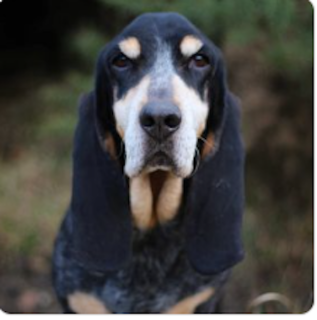
Traceable back to the 14th century, the Basset Bleu is one of the oldest breeds of French Basset and is believed by some to be descended from the large Grand Bleu de Gascogne and the Saintongeois Basset, though others speculate that the Basset Bleu is a natural mutation of the Grand combined with selective breeding for shorter legs in order to slow down the breed. Since the breed was created long before breeders kept records of breedings, its true origins may never be known with certainty. That we know the antiquity of the breed is as a result of paintings created in Gascony in the 1300’s, as well as from the writings of Gaston III of Fox-Bearn, the author of the classic treatise on medieval hunting, The Livre de Chasse. He was known to keep a pack of Basset Bleu de Gascognes.
Before the French Revolution, hunting with the Basset Bleu was the privileged purview of the upper class. While hunting became more accessible to the lower classes after the Revolution, many didn’t own a horse, and a slower, short-legged hunting dog became necessary for the hunter on foot. As devastating as the Revolution was to most French breeds, the Bleu actually grew in popularity as a result, for a time, anyway. Hunting with pack hounds eventually fell out of favor in France, and other breeds got more popular. By 1911, the Basset Bleu de Gascogne was very nearly extinct.
Happily, Alain Bourbon, an enthusiastic fan of the breed kept that from happening. Whether he gathered together whatever Bleu that still remained, or he recreated the breed using close relatives, Bourbon is credited with the continued existence of the breed.
The FCI recognized the Bleu in 1963, and the United Kennel Club followed in 1991.
Image of Mabelle D’an Noaned Avec Caelestibleu appears here courtesy owner, Jenny Bartlett
